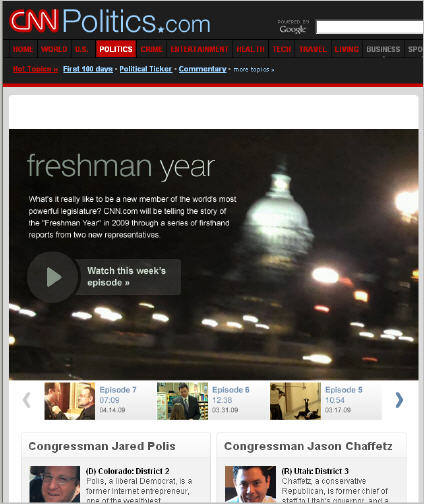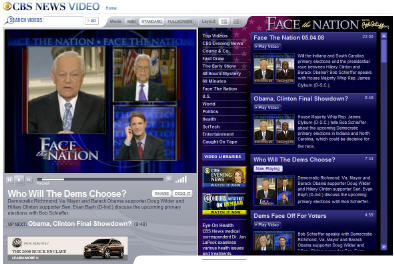-
Inside the Stream Podcast: CNN+ Launch and Apple’s Streaming
Welcome to this week’s edition of Inside the Stream, the podcast where nScreenMedia’s Chief Analyst Colin Dixon and I take listeners inside the world of streaming video.
First up this week, Colin and I discuss CNN+ which launched this week. For now there’s limited connected TV availability, so that’s a key challenge to surmount. Overall we agree it’s a smart strategy by CNN and will fit well with other streaming services from WarnerMedia Discovery.
Then we catch up on Apple’s latest streaming moves, including starting to stream Major League Baseball games and winning the Oscar for CODA.
Listen to the podcast (23 minutes, 9 seconds)
Browse all previous podcasts
Subscribe to Inside the Stream
Apple Podcasts Google Podcasts Spotify Amazon Music RSSCategories: Podcasts
Topics: Apple TV, CNN, Podcast
-
VideoNuze Podcast #231: More Questions Than Answers Around the "Appification of TV"
I'm pleased to present the 231st edition of the VideoNuze podcast with my weekly partner Colin Dixon of nScreenMedia.
This week we explore the concept of the "appification of TV," which means accessing TV programming and experiences via apps on a set-top box or connected TV device vs. through a typical linear or even on-demand/DVR model. Of course apps are already hugely popular on tablets and smartphones, but not nearly so on TV, as they require either a connected TV device or a set-top box that can run apps.
In the latter category is Comcast's new X1, which the company is aggressively rolling out and which currently has a limited assortment of apps available (back in February I shared a video demo of how the NBC Olympics "Live Extra" app works on X1). This week Colin saw a demo of another example - CNNx - a recently announced app from CNN, which we use as a jumping off point for our discussion.
As we discuss, the appification of TV raises a slew of questions, including whether it's a net positive for the broadcast/cable network, the pay-TV operator and the viewer. Colin believes that competitive pressure from online providers will spur the appification process forward, though I think caution will be the watchword particularly given uncertainties around monetizing apps on TV. We raise more questions than we have answers around this provocative topic, but it's all great food for thought.
Listen in to learn more!
Click here for previous podcasts
Click here to add the podcast feed to your RSS reader.
The VideoNuze podcast is also available in iTunes...subscribe today!Categories: Apps, Devices, Podcasts
-
CNN BuzzFeed Channel to Capitalize on Short-Form Video and Syndication Trends
CNN and BuzzFeed are partnering to create a new YouTube channel called "CNN BuzzFeed" to break original news online. The channel will feature current and archived CNN video and like all BuzzFeed content, is targeted to a younger, social media savvy audience.
CNN BuzzFeed will capitalize on two of the most important attributes of today's online video landscape: short-form and syndication. Last week, data from ad manager FreeWheel showed that "Digital Pure-Play" content providers grew their video views by 47% year-over-year (with 84% of their views coming via syndication to 3rd-party sites), while views from long-form "Linear + Digital" providers (e.g. broadcast and cable networks) decreased by 8%.Categories: Cable Networks, Social Media
Topics: BuzzFeed, CNN, FreeWheel
-
4 Items Worth Noting for the Oct 26th Week (Counting online video views, Zappos prank videos, 3DTV, 2010 trends)
Following are 4 items worth noting from the Oct 26th week:
1. Online video viewership claims are murky - Props to Jim Louderback, CEO of Revision3, for his opinion piece in AdAge this week, "Where's the Outrage Over Online Video Viewership Claims" in which he cites multiple examples of how content providers' hyperbole and the media's lack of fact-checking/analysis allow all kinds of ridiculous viewership numbers to gain traction as fact. Compounding things is the inconsistent definition of what even constitutes a "view." Jim notes that a fraction-of-a-second play start often can be enough. For advertisers in particular, trying to understand where to place their spending in the emerging online video medium, it is "buyer beware." A great reminder of how immature the online video industry remains.
2. Zappos's "world's fastest nudist" viral video campaign adds to media's gullibility - The NY Times had a great item this week on Zappos's "world's fastest nudist" campaign, a series of humorous videos on YouTube showing a guy named Donnie streaking around the streets of New York with nothing but a fanny pack on.
While the videos are clever, the media that picked them up and ran with them as being real are now looking decidedly dim. CNN's Anderson Cooper surely tops the gullibility list, as he and anchor Erica Hill featured one of the videos (showing Donnie buying a taco at a food stand) on AC 360's nightly "The Shot" feature. Cooper blithely passes on that Donnie "holds over 400 nude speed records..." One suspects Walter Cronkite would have dug in and not have been duped by Zappos. However, I'm hardly one to talk, as I was taken in by the "Megawoosh Waterslide Video" this past summer. The old adage "don't believe everything you read" really needs to be updated to "don't believe everything you watch." Meanwhile, Zappos undoubtedly loves all the free publicity.
3. Enough of HDTV, get ready for 3DTV - Speaking of not believing what you watch, and shifting focus somewhat from online video, I got my first peek at what 3DTV looks like earlier this week. 3D has become a mini-rage recently, with various TV set manufacturers launching 3D-enabled models, looking to drive content creators to jump on the 3D bandwagon. The catch to 3D video is that it's much more expensive to produce because of the need for multiple cameras. That may be OK for movies where the extra cost can be recouped through higher ticket prices, but for regular TV shows it's been a serious obstacle.
However, the approach used by a small NJ-based company named HDLogix, whose demo I saw, introduces a workaround to this issue. Instead of requiring original production to be shot in 3D, the company runs existing video through its algorithms to dynamically generate 3D effects (I saw segments of the movie "300"). That means no additional production expense is incurred by the content creator. Don't ask me any more about how it works, as the technology is way outside my sweet spot. I will say this, it's pretty cool stuff and I could see 3D adding a lot of new value to online video, especially advertising.
4. What to look for in 2010 - One last follow-up to the CTAM Summit panel I moderated on Tuesday. My last question to the panelists was to name 1 thing that the 1,500+ cable industry attendees in the audience should be paying most attention to in 2010. These were their answers:
Paul Bascobert (Chief Marketing Officer, Dow Jones & Company) - e-book readers make huge advances, especially with a new Apple product hitting the market
Matt Bond (EVP, Content Acquisition, Comcast) - the "customer is king" - stay focused on that
Andy Heller (Vice Chairman, Turner Broadcasting System, Inc.) - the advent of 4G mobile networks and adoption of the "mobile Internet"
Jason Kilar (CEO, Hulu) - follow your companies on search.twitter.com to stay in touch with what your customers are saying
David Preschlack (EVP, Disney and ESPN Networks Affiliate U.S. Sales and Marketing) - the number of access points for content providers will continue to explode
Peter Stern (EVP & Chief Strategy Officer, Time Warner Cable) - make every interaction with customers an opportunity to build a positive relationship
Great food for thought.
Enjoy your weekends!
Categories: Brand Marketing, Indie Video, Predictions, Technology, Video Sharing
Topics: CNN, CTAM, HDLogix, Revision3, Zappos
-
iPhone 3G S Poised to Drive User-Generated Mobile Video
After reading many different reviews over the weekend of the just-released iPhone 3G S, it's hard not to conclude that this device is going to be a serious catalyst for mobile video recording and consumption. Since I don't have an iPhone 3G S myself (I'm a Verizon subscriber), I've been relating to the iPhone phenomenon through friends and from what I've read.
Specifically, the iPhone 3G S is poised to push user-generated video content to a new level, as Daisy first explained on our podcast a week and a half ago. That's because, as reviews at TechCrunch, Business Insider and others have pointed out, the iPhone 3G S dramatically improves the convenience of the mobile video experience that Flip and other video cameras have pioneered. Certainly the biggest benefit is that iPhone 3G S owners will effectively have a low-end Flip in their pockets at all times, meaning they're ready to shoot video whenever they want, not just when they remembered to bring along their video camera.
I can relate to this because about 6 months ago I bought a Creative VadoHD video camera (basically a cheaper, somewhat more powerful version of the Flip MinoHD). It's a nifty little device, except for weak zoom and a lousy mic. But the big problem is that I never seem to have it with me at the spontaneous moment I want to shoot video. In other words, like my digital camera, it hasn't broken into the keys/wallet/cell phone must-have-when-leaving-the-house checklist. Nor do I expect it ever will.
To the contrary, iPhone 3G S owners will become conditioned to always having video capability with them. And because the iPhone 3G S is a connected device (unlike Flip, Vado or others), you can upload your
 videos immediately, to YouTube, of course (and with YouTube's AutoShare feature those videos can now be distributed to Facebook and Twitter as well). The iPhone 3G S comes with video editing on the device, allowing you to instantly share just what you want. Simply put, having robust video recording and editing subsumed into a cell phone/smartphone is huge.
videos immediately, to YouTube, of course (and with YouTube's AutoShare feature those videos can now be distributed to Facebook and Twitter as well). The iPhone 3G S comes with video editing on the device, allowing you to instantly share just what you want. Simply put, having robust video recording and editing subsumed into a cell phone/smartphone is huge. Of course the iPhone 3G S isn't perfect, nor is it for everyone. The biggest hurdle is that you need to be an AT&T subscriber, which rules out a big chunk of the market, unless you're ready to switch. iPhone 3G S video is SD-only for now vs. widespread HD-quality on Flips and others (though that will no doubt change soon enough). Actual battery life is still uncertain, and I for one continue to wonder how willing people will be to risk draining their batteries shooting and watching video.
Still the iPhone 3G S brings us closer to a world where no significant spontaneous event will ever go unrecorded. Things like emergency airplane landings and instances of police brutality will have a much higher chance of being captured in the future. That makes me think about what role iPhone 3G S and other video-enabled smartphone users can have in the traditional news gathering process? How can they tap into this energy to reinvent their own models? We've already seen the success CNN is having with its iReports. What's next, as news gatherers evolve to the instantaneous mobile video world?
The iPhone continues to set the bar in mobile video. But with other smartphones from Palm, Blackberry and Google being introduced, there is much more innovation still ahead. For sure we are moving into an era when mobile recording and playback is going to become commonplace.
What do you think? Post a comment now.
Categories: Mobile Video
-
Cable TV Networks are Launching Original Broadband-Only Webisodes
Over the past couple months I've noticed a trend toward cable TV networks producing short webisode series solely for broadband distribution. It's still quite early, but the trend offers some insights into these networks' programming strategies.
To date most cable networks have put a lot of promotional clips online and a few have even put some full length programs up as well. But for the most part cable networks have been constrained in how much original content they distribute online due to their lucrative monthly affiliate deals with cable/telco/satellite operators (though this too may change with Comcast and TWC pursuing online distribution plans).
I've noticed these webisodes announced just in the last couple of months:
- Freshman Year (CNN) - follows the day-to-day lives of 2 first-year congressmen
- In Men We Trust (WETV) - 4 single women learn the rules of the dating game
- Great and Telling Tales by Timothy Dickinson (History) - animated shorts explaining unexpected moments in history
- Off Track with Tony Stewart (Turner Sports/NASCAR) - behind the scenes with star racing driver
- Special Report with Bret Baier (Fox News) - webcast continuation of on-air news discussion
- Walt's Warning (AMC) - first-person video featuring "Breaking Bad" cast
- FoxBusiness.com Live (FBC) - one hour weekday financial show
(No doubt there are others as well, so apologies to those I may have missed)
The webisode format breaks the traditional limitation of having a finite 24 hours/day of "shelf space" for networks to program. I think what's happening here is that cable networks are experimenting with the low-cost webisode format both to reach online users and also to see what might graduate to on-air. The webisodes allow them to bridge their brands between traditional TV and broadband to see what sticks. And some webisodes may even making money for their networks already. "Off Track" for example is showcased in an Armor All "Owner Center" sponsored environment.
CNN's Freshman Year is a good example of how one network is pushing the envelope. In the series, CNN has given Flip video cameras to 2 new congressmen, who use them to show what life is really like on and off Capitol Hill (it's not glamorous that's for sure). The concept is a natural extension for CNN's politically-interested audience, and capitalizes on the tailwind of the '08 election cycle. While the production values are well below what's typically seen on-air, there's something compellingly authentic (and yes voyeuristic) about the wobbly, poorly framed footage offered up by the congressmen. For sure you come away with a far better sense of what these guys' lives are like than you would from a slickly-produced 1 hour special.
All of the 7-13 minute episodes have pre and post rolls, from brands like IBM and Sprint. I've noticed CNN starting to promote the series through on-air spots as well, which is a key webisode audience-building all the networks have. However, CNN really needs to make the series more visible on the web site. Aside from a periodic ad, a site visitor wouldn't know the series existed or how to find it. This is a common problem with the other networks' sites as well.
It's way too early to know how sticky the webisode concept will be for cable TV networks, but on the surface I think it offers a lot of opportunity. Cable networks are not immune from audience fragmentation and consumers' changing expectations. Finding ways to reinforce viewer loyalty and generate additional revenues is a must.
What do you think? Post a comment now.
Categories: Cable Networks
Topics: AMC, CNN, FBC, Fox News, History, NASCAR, Turner, WETV
-
September '08 VideoNuze Recap - 3 Key Themes
Welcome to October. Recapping another busy month, here are 3 key themes from September:
1. When established video providers use broadband, it must be to create new value
Broadband simultaneously threatens incumbent video businesses, while also opening up new opportunities. It's crucial that incumbents moving into broadband do so carefully and in ways that create distinct new value. However, in September I wrote several posts highlighting instances where broadband may either be hurting existing video franchises, or adding little new value.
Despite my admiration for Hulu, in these 2 posts, here and here, I questioned its current advertising implementations and asserted that these policies are hurting parent company NBC's on-air ad business. Worse yet, In "CNN is Undermining Its Own Advertisers with New AC360 Live Webcasts" I found an example where a network is using broadband to directly draw eyeballs away from its own on-air advertising. Lastly in "Palin Interview: ABC News Misses Many Broadband Opportunities" I described how the premier interview of the political season produced little more than an online VOD episode for ABC, leaving lots of new potential value untapped.
Meanwhile new entrants are innovating furiously, attempting to invade incumbents' turf. Earlier this week in "Presidential Debate Video on NYTimes.com is Classic Broadband Disruption," I explained how the Times's debate coverage positions it to steal prime audiences from the networks. And at the beginning of this month in "Taste of Home Forges New Model for Magazine Video," I outlined how a plucky UGC-oriented magazine is using new technology to elbow its way into space dominated by larger incumbents.
New entrants are using broadband to target incumbents' audiences; these companies need to bring A-game thinking to their broadband initiatives.
2. Purpose-driven user-generated video is YouTube 2.0
In September I further advanced a concept I've been developing for some time: that "purpose-driven" user-generated video can generate real business value. I think of these as YouTube 2.0 businesses. Exhibit A was a company called Unigo that's trying to disrupt the college guidebook industry through student-submitted video, photos and comments. While still early, I envision more purpose-driven UGV startups cropping up in the near future.
Meanwhile, brand marketers are also tapping the UGV phenomenon with ongoing contests. This trend marked a new milestone with Doritos new Super Bowl ad contest, which I explained in "Doritos Ups UGV Ante with $1 Million Price for Top-Rated 2009 Super Bowl Ad." There I also cataloged about 15 brand-sponsored UGV contests I've found in the last year. This is a growing trend and I expect much more to come.
3. Syndication is all around us
Just in case you weren't sick of hearing me talk about syndication, I'll make one more mention of it before September closes out. Syndication is the uber-trend of the broadband video market, and several announcements underscored its growing importance.
For example, in "Google Content Network Has Lots of Potential, Implications" I described how well-positioned Google is in syndication, as it ties AdSense to YouTube with its new Seth MacFarlane "Cavalcade of Cartoon Comedy" partnership. The month also marked the first syndication-driven merger, between Anystream and Voxant, a combination that threatens to upend the competitive dynamics in the broadband video platform space. Two other syndication milestones of note were AP's deal with thePlatform to power its 2,000+ private syndication network, and MTV's comprehensive deal with Visible Measure to track and analyze its 350+ sites' video efforts.
I know I'm a broken record on this, but regardless of what part of the market you're playing in, if you're not developing a syndication plan, you're going to be out of step in the very near future.
That's it for September, lots more planned in October. Stay tuned.
What do you think? Post a comment!
Categories: Aggregators, Analytics, Brand Marketing, Broadcasters, Magazines, Partnerships, Syndicated Video Economy, UGC
Topics: ABC, Anystream, AP, CNN, Doritos, Google, Hulu, MTV, NY Times, Taste of Home, thePlatform, Unigo, Visible Measu, Voxant, YouTube
-
Presidential Debate Video on NYTimes.com is Classic Broadband Disruption
Here's a classic example of how broadband is causing traditionally distinct worlds to collide: on Friday night the NYTimes.com opened up a dedicated streaming video window on their home page, where the presidential debate played for the full hour and a half. I watched the first half of the debate there, before switching on the TV and watching it on CNN HD. While HD was obviously superior, the NYTimes.com's video was more than adequate (though disappointing there was no full screen option).
Saturday morning and NYTimes.com is offering the video on demand, with an accompanying full written transcript. You can search (try typing "wrong" to see), to get how many times each candidate used that term, and then jump to the points in the video when it was used (alas, it would be great if the Times gave the ability to clip that specific segment and virally distribute it). The Times does offer a "check point" feature, where it fact checks the candidate's assertions. Note that other sites like ABCNews.com and CNN.com have the debate on demand today as well, but not the interactive features that NYTimes.com has.
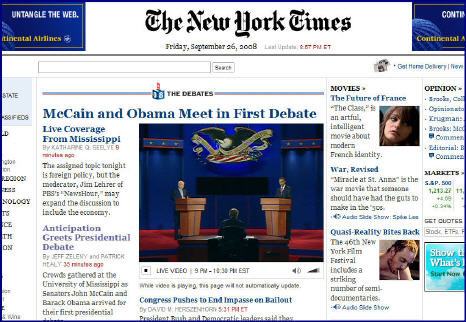
Stop and consider how significant all of this is - a print publisher using broadband to offer a clear alternative to broadcasters and cable networks in carrying high-quality video. It's a great value proposition just for people without access to TVs at the moment of the live event, but more important, it provides a glimpse of some very interesting additional opportunities for NYTimes.com.
For example, the site could host its own post-debate punditry show, assembling its all-star lineup of daily Times columnists. Dedicated Times readers would no doubt love to see a roundtable with Frank Rich, Tom Friedman, William Kristol, Maureen Dowd and others dissect the candidates' performances, rather than waiting for their thoughts to come in columns over the next several days. Also think about how this type of show would scoop Sunday talk shows like NBC's "Meet the Press" or ABC's "This Week with George S." in bringing serious punditry to political junkies who can't wait.
In fact, the NYTimes.com could even offer viewers the ability to interact with their columnists, building on the wildly popular commenting feature already available with each daily piece in the paper itself. This type of immediacy and interactivity would be very compelling. The site could also offer the live debate video stream with a companion chat area that would enable viewer engagement during the debate itself (see Paltalk for an example of how this could work).
And last but not least, NYTimes.com could offer a single premium sponsorship slot to underwrite its whole debate coverage. Think Mercedes, Four Seasons, Cartier or other upscale brands might be interested?
As I've said many times, broadband blurs previously siloed worlds, bringing more competition to traditional players like broadcast and cable networks. They now need to deliver more to stay competitive. For video entrants like NYTimes, broadband creates enormous new opportunities to both leverage core assets/talent and pioneer new and different ways to create value. Another reminder why broadband is so disruptive for so many.
What do you think? Post a comment.
Categories: Broadcasters, Cable Networks, Newspapers, Politics
Topics: ABC News, CNN, NYTimes.com, Paltalk
-
CNN is Undermining Its Own Advertisers with New AC360 "Live Webcasts"
Here's an example of how convoluted broadband's use can be.
On CNN's AC360 program last night, Anderson Cooper was promoting "live webcasts" with news anchor Erica Hill, which would run during on-air commercial breaks. As explained here, the idea is that CNN viewers can go "behind the scenes" to continue their AC360 experience by watching the live stream on their computers. I dutifully did this and watched Hill and Cooper somewhat mindlessly chatting/flirting for several minutes.
But wait: if CNN is urging on-air viewers to turn their attention to these "webcasts" during commercial breaks, then that means that CNN is diverting attention from its own on-air advertisers. That undermines CNN's all-important advertiser value proposition. That of course begs the question: is CNN's ad sales team on board with these webcasts? And if so, what are they thinking??
I guess the argument could be made that CNN believes anyone who would jump online would be multi-tasking, so they'd still have their TV on. Yet at a minimum they'll mute their TV's audio (as I did) to hear the webcast's audio. That means the users' eyes and ears are now focused online instead of on-air.
CNN has been laudably in the forefront of weaving online technology into their on-air programs. Tune in to anchor Rick Sanchez's show some time and you'll him juggling an orgy of on-air Twittering, Facebook emailing and YouTube video sharing. Cooper too has been relentlessly flogging his AC360.com web site since its recent relaunch.
That all works, in my opinion. But the "live webcasts" do not. They might work after or before the on air program, but not during. At a time when advertiser relationships are more tenuous than ever due to the rise of DVRs, VOD and broadband, the last thing a network should be doing is undermining their value proposition any further. Someone at CNN no doubt thought, "hey these will be really cool." That may be, but in my opinion, they're not smart business. Broadband should complement existing franchises not undermine them.
What do you think? Post a comment.
Categories: Cable Networks
Topics: CNN
-
CNN Gets UGC Foothold with "iReport" Feature
Give CNN credit: their 4 month-old "iReport" feature seems to making steady progress, demonstrating how a traditional news organization can effectively incorporate user-generated content.
If you haven't been following iReport, it is essentially a user generated content feature on CNN.com that
 incents CNN viewers to upload their own photos and videos to the site. Sometimes these uploads are in response to "assignments" CNN has created such as "Midwest flooding," "Celebrity look-alikes" or "Is Jesse Jackson relevant?" Other times it's just users uploading content they find compelling. As an extra inducement, CNN will periodically show these iReport segments on-air (as an "AC 360" viewer, I notice them several times per week).
incents CNN viewers to upload their own photos and videos to the site. Sometimes these uploads are in response to "assignments" CNN has created such as "Midwest flooding," "Celebrity look-alikes" or "Is Jesse Jackson relevant?" Other times it's just users uploading content they find compelling. As an extra inducement, CNN will periodically show these iReport segments on-air (as an "AC 360" viewer, I notice them several times per week). CNN benefits from the iReport content in several ways. First and most obvious, CNN is creating a virtual extension of its news gathering operation, providing it access to free content that is often as good or better in terms of its immediacy and relevance that what CNN itself could produce. In this era of belt-tightening by all news organizations, CNN is able to do more with less.
Second, iReport generates a powerful "citizen journalist" engagement opportunity for both ardent newshounds and amateurs alike to help shape the news, not just passively watch it. This helps CNN position itself as more relevant and in-touch, giving it a competitive advantage vs. its peers.
Last, iReport gives CNN an ongoing stream of promotional opportunities, keeping the brand fresh and in-touch with audiences. Last night, Campbell Brown (who was sitting in for Anderson Cooper as anchor on
 AC360) provided another great example: a new iReport Film Contest, which challenges users to produce short films from the campaign trail. So rather than the perpetual pundit talking heads, this contest will provide a fresh look at the current election. (I must note regrettably though, that currently clicking on the AC360 site's link to learn more about the contest's details yields a "Page Not Found" error. Ugh.)
AC360) provided another great example: a new iReport Film Contest, which challenges users to produce short films from the campaign trail. So rather than the perpetual pundit talking heads, this contest will provide a fresh look at the current election. (I must note regrettably though, that currently clicking on the AC360 site's link to learn more about the contest's details yields a "Page Not Found" error. Ugh.)Broadband poses particular challenges for broadcast and cable news organizations, not only because it shifts consumption away from linear-scheduled newscasts to pure on-demand, but also because it enables news to be covered and made by amateurs outside the traditional boundaries of bureaus and assignment desks. Figuring out to responds to and shape these new forces is a key challenge for all news organizations. With the iReport feature, CNN seems to off to a good start.
What do you think? Post a comment now!
Categories: Cable Networks, UGC
-
Sunday Morning Talk Shows Need Broadband Refresh
In the heat of the Democratic primary, the five major Sunday morning talk shows have recently taken on greater prominence. For political junkies like me, even after a week's worth of endless campaign coverage, it is great sport to watch the candidates and their surrogates put the best face on the week's events, while eagerly trying to tee up issues for the coming week's news cycle.
The Sunday shows are also perfect fodder for broadband video consumption. On-air they are neatly segmented by guests and topics, their archives offer a vivid research opportunity for both editorial and user-driven curation, and the audiences that tune in are upscale and appealing to advertisers.
With all this going for them, I decided to investigate the online presence of the five Sunday morning shows, ABC's "This Week with George Stephanopoulos," CBS's "Face the Nation with Bob Schieffer," FOX's "Fox News Sunday with Chris Wallace," NBC's "Meet the Press with Tim Russert" and CNN's "Late Edition with Wolf Blitzer."
Though all of the sites had their strengths, as a group I found them to be surprisingly average initiatives, especially in comparison to the superb efforts these same networks have mounted for their online entertainment programming. (Note that all I found for "Late Edition" was a brochure page)
"FTN" would have to rank at the top of my list, primarily because it segments the show by its guests and topics and displays them in the user-friendliest manner. This allows the user to quickly zero in on desired segments. "This Week" and "MTP" do some of this as well, though I found their presentation not as straightforward. What's missing from all are related clips across episodes curated in a meaningful way. Presentation is very episode-centric.
While all the sites rely heavily on pre-roll ads, "FTN" gets credit for using some frequency capping. "This Week," seems to ignore the best practices that ABC.com follows in presenting its shows with limited interruptions. Not only does it not frequency cap, it also ran the same 2 ads - one for Intel and one for Verizon Wireless - over and over. Needless to say this became tiresome after clicking to watch several segments.
Meanwhile, navigation and available content on these sites are all over the board. "MTP" offers a link to watch the whole program with limited interruptions, while "FNS" offers a text transcript of the most recent program, but not a video of the whole program. "This Week's" main text navigation has links to pure text stories, text stories with embedded video clips, and video clips alone, but no way to sort the list by media type. Search on each site also yields highly diverse results - some video, some not. One missed opportunity is that none offer any user editing features. Putting together your own highlights reel to be embedded on a blog or social networking site would likely be great fun for many hard-core viewers.
The Sunday talk shows offer dynamite content, highly leverageable for broadband consumption. Hopefully as the political season rolls on we'll see the networks recognize this and continue to invest in new features and improved usability.
What do you think? Post a comment and let us all know!
Categories: Broadcasters, Cable Networks
Topics: ABC, CBS, CNN, FOX, NBC
-
3 Broadband Video Snippets to End the Week
Closing out another busy week, here are 3 diverse broadband video snippets that hit my radar in the past few days:
1. YouTube Drives the Political Newscycle
Back in December, in 6 Predictions for 2008, I suggested that "2008 is the year of the broadband presidential election." This seems to become more evident with each passing week. I find that particularly when watching cable news, YouTube's influence just keeps on growing.
For example, I'm a fan of "AC360" on CNN, which I try to catch at 10pm each night. This week the show was constantly replaying the YouTube videos of Rev. Jeremiah Wright that have dogged the Obama campaign. Conversely, a few weeks ago, Obama got a great tailwind from the massive attention paid to the viral "Yes We Can" music video sensation by will.i.am. That of course was on top of the earlier "Obama Girl" phenomenon. Separately, the McCain campaign just yesterday fired a campaign worker for posting a controversial video on YouTube about Obama and race. This too was covered on AC360 last night. Then of course there were the YouTube co-sponsored debates, offering video-based questions that were constantly replayed afterward.
The point of all this is that broadband video has turned election coverage upside down, making it incredibly hard for candidates to control the political newscycle. The "democratizing" effect of YouTube means that on any given day, at any given moment, something may get posted which diverts the campaign's attention. And with major media outlets paying such close attention to YouTube, everything is immediately amplified. Not since the early 1960s when TV began influencing presidential politics have we seen a new medium have such a profound impact on an election. And we still have 8 months to go until November...who knows what's yet to come!
2. SI Vault is Addictive
On to something more fun, if you haven't yet checked out Sports Illustrated's new "SI Vault" site just launched this week, I suggest you do. It's a highly addictive trip down memory lane. SI has digitized all of its assets and also made available non-SI content, all in one easy-to-use location powered by Truveo. Focusing on video, I found Franco Harris's "Immaculate Reception" from the 1972 Steelers-Raiders playoff game and also Doug Flutie's famous "Hail Mary" pass to beat Miami in 1984. I could have spent hours at the site, although it's not perfect. I tried finding Tom Watson's 1982 U.S. Open chip-in at Pebble Beach to beat Jack Nicklaus, but alas no results were found. Obviously all this stuff is available elsewhere online, but SI Vault creates a great context for sports fans to enjoy themselves, wrapping SI and non-SI content together in one nice package.
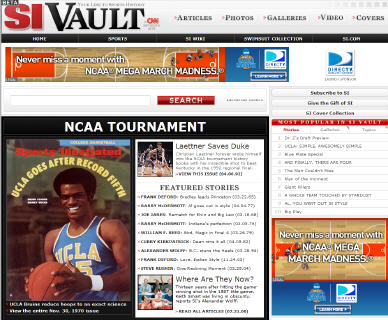
3. Apple's Roadblocks are Baaaack
And for even more fun, I encourage you to check out WSJ.com and NYTimes.com today. Apple is "roadblocking" the home pages of both again with a new Mac vs. PC ad, as they did back on Jan. 17th. This means that Apple has bought out all the home page leaderboard inventory on these 2 sites, so every time a visitor comes today, they see the same Apple ad. With all the talk about broadband video advertising, pre-rolls, overlays, etc, Apple again shows with its roadblocks how a little bit of creativity with rich media ad units can go a really long way. The ads are a great mix of interruption and opt-in and are no doubt highly effective branding units for Apple. Have a look and enjoy.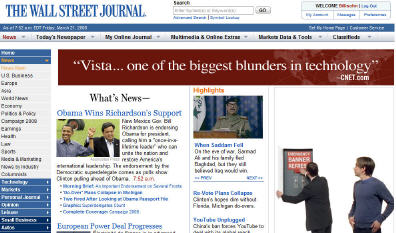
Categories: Brand Marketing, Cable Networks, Politics, Predictions, Sports, UGC, Video Sharing
Topics: Apple, Barack Obama, CNN, NYTimes.com, Sports Illustrated, Truveo, WSJ.com
-
Microsoft Flexes Broadband Muscles at CES
Microsoft grabbed the early PR spotlight at the Consumer Electronics Show (CES), now underway in Las Vegas, announcing a variety of deals across the broadband video spectrum. The deals, announced by Bill Gates in his traditional night 1 keynote, reinforce Microsoft's intentions to play multiple roles in what Gates calls the "first true Digital Decade."
Here's a look at Microsoft's deals and why they matter:
NBCU 2008 Olympics on MSN, using Silverlight
Microsoft and NBC, which has the broadcast rights to the '08 Summer Games from Beijing, announced that MSN would be the exclusive partner for NBCOlympics.com including thousands of hours of live video
 coverage, and that Silverlight, which is Microsoft's "Flash-killer", would be used. As I mentioned in my "6 Predictions for 2008", the '08 games are going to be the biggest broadband video event yet. The deal gains MSN lots of traffic and Silverlight lots of exposure and downloads, not to mention serious validation as a live streaming platform if it executes well.
coverage, and that Silverlight, which is Microsoft's "Flash-killer", would be used. As I mentioned in my "6 Predictions for 2008", the '08 games are going to be the biggest broadband video event yet. The deal gains MSN lots of traffic and Silverlight lots of exposure and downloads, not to mention serious validation as a live streaming platform if it executes well.ABC/Disney and MGM content on XBox LIVE
In a further move to bolster the premium-quality content available in XBox LIVE (the content offering that accompanies XBox 360), Microsoft announced that both ABC/Disney and MGM would now be providing both SD and HD content. These moves bring XBox LIVE's catalog closer to parity with iTunes, while
 keeping up the competition with Amazon Unbox and other stores. Separately, Microsoft said that XBox racked up 17.7 million units sold during the '07 holiday season.(correction, Microsoft press release misstated this number. Holiday sales were actually 4.3 million units, bringing cumulative units sold to date to 17.7 million, thx Karl)
keeping up the competition with Amazon Unbox and other stores. Separately, Microsoft said that XBox racked up 17.7 million units sold during the '07 holiday season.(correction, Microsoft press release misstated this number. Holiday sales were actually 4.3 million units, bringing cumulative units sold to date to 17.7 million, thx Karl)XBox users have been remarkable active purchasers and downloaders using XBox LIVE, and previous briefings I've conducted with XBox executives suggest that the initiative has been particularly successful with HD. Since Xbox is purchased primarily as a gaming platform, it serves as a great Trojan horse opportunity for Microsoft to gain broadband access to the TV.
 Meanwhile, XBox LIVE has served as the deal unit for Zune's library as well, so these moves are important to watch as they benefit Microsoft's efforts to dislodge iPod from its perch as the leading digital media player. Only disappointment here is no ad-supported counterpart was announced for ABC programs, leaving AOL as ABC's only announced broadband syndication partner, as best I can tell.
Meanwhile, XBox LIVE has served as the deal unit for Zune's library as well, so these moves are important to watch as they benefit Microsoft's efforts to dislodge iPod from its perch as the leading digital media player. Only disappointment here is no ad-supported counterpart was announced for ABC programs, leaving AOL as ABC's only announced broadband syndication partner, as best I can tell.BT and XBox 360 Integration
Microsoft leveraged Xbox 360 for another convergence play, announcing with BT that the company's "BT Vision" IPTV service would be available for XBox 360 owners as an integrated service offering. This means that no separate set-top box would be required for BT Vision subs. Though the box won't roll out until mid '08, this concept has compelling upside for both sides and could be a nice blueprint for future IPTV deals. It eliminates set-top capex for BT, while providing strong marketing benefits to both parties, helping drive broadband/TV convergence on the back of the popular XBox gaming console.
Showtime, TNT and CNN with new apps on Mediaroom, Samsung supporting Extender
Elsewhere, Microsoft announced that Showtime, TNT and CNN would be creating new apps for Microsoft's Mediaroom IPTV platform, which it says is now installed on 1M set-tops globally. And lastly, that Samsung will support Extender for Windows Media Center, which means that HD content can be sent over wired or wireless-N networks from PC to TV. Extender hasn't caught on yet, but Microsoft is continuing to push it as a bridge device. I've yet to test it, but have that on my list of to-do's.
Taken together, these announcements from Microsoft show the company's vast resources allow it to play a role in all aspects of the broadband era - software, devices, services, content, gaming, etc. Less pronounced in these deals was the company's recently added online advertising prowess, which will soon be applied to broadband video as well. Stay tuned for news on this front as '08 unfolds.
Categories: Aggregators, Broadcasters, Cable Networks, Downloads, FIlms, Games, HD, International, IPTV, Partnerships, Sports
Topics: ABC, BT, CNN, Disney, MGM, Microsoft, NBC, Olympics, Samsung, Showtime, TNT, Xbox 360, Xbox LIVE
-
CNN Sets Pipeline Free
News from CNN that it is jettisoning the subscription model for its Pipeline service. Smart move for them. Based on our recent report on the top 75 cable TV networks’ broadband video initiatives, I now count only 3 networks still using a subscription model (note, all in conjunction with free, ad supported video).Those 3 are:-
Golf Channel “The Drive” Premium Membership - $29.95/year (lots of instructional video – makes sense to charge)
-
CourtTV “EXTRA” - $5.95/mo (feeds of multiple trials simultaneously, for the armchair criminologists among you)
-
Weather Channel “Desktop Max” $29.99/year – (really the ad-supported Desktop service, but minus the ads, and also more comprehensive than just video)
Categories: Advertising, Cable Networks
Topics: CNN, CourtTV, Golf Channel, Weather
-
Posts for 'CNN'
|

